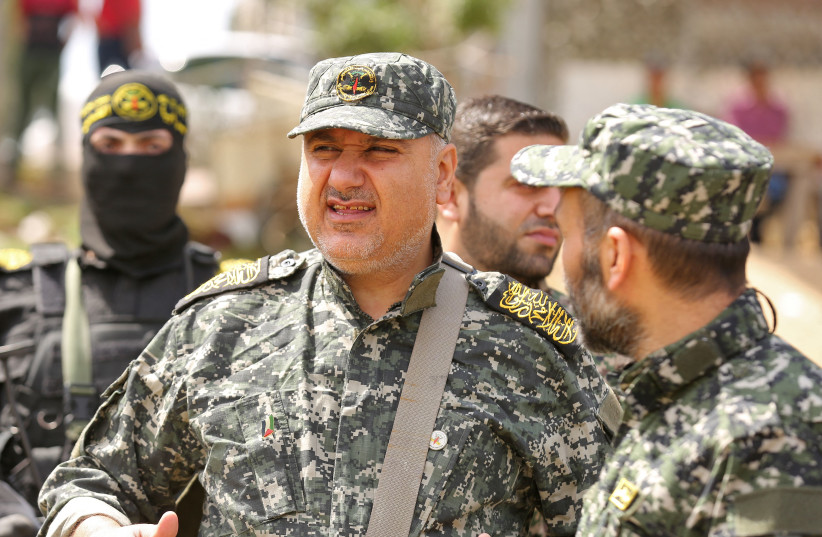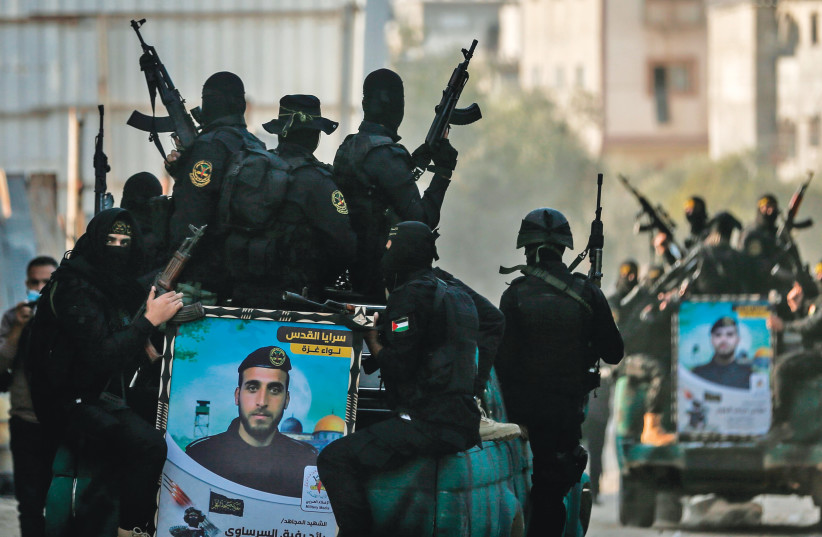On November 12, 2019, the IDF fired a missile into the home of the commander of the Palestinian Islamic Jihad in northern Gaza, Baha Abu al-Ata, killing him and his wife and setting off two days of intense fighting between Israel and the terrorist organization, known in Israel as Operation Black Belt.
About three years later, in Operation Breaking Dawn, Israel and Islamic Jihad faced off again in another short round of fighting. But some important factors have changed since 2019.
<br>The buildup
The buildup leading to this operation was somewhat similar to Operation Black Belt both in its target and in its effort to thwart planned attacks against Israelis. However, it did differ in some significant ways.
The 2019 assassination of Abu al-Ata was preceded by months of rocket fire and attacks against Israel, orchestrated by the Islamic Jihad commander who was planning further attacks as well. The IDF warned multiple times that he was orchestrating the violence from the Gaza Strip and, after his assassination, stressed that the strike was conducted in order “to bring stability to the region and to save lives.”

The buildup to Operation Breaking Dawn was done differently, however. To the public, it began last week with the arrest of Bassem al-Saadi, an Islamic Jihad official in the West Bank. Shortly after the arrest, the IDF stated that there were concrete warnings of plans by the terrorist group to attack Israelis near the border, and implemented strict movement restrictions on communities near the Gaza Strip.
After four days of restrictions on Israelis near the Gaza border – with residents there expressing outrage at being essentially under lockdown, while Gaza residents had full freedom of movement – the IDF launched a preemptive strike against Islamic Jihad targets in the coastal enclave, assassinating Tayseer Jabari, the official who had replaced Abu al-Ata.
A Walla report on Monday revealed that the plans for Operation Breaking Dawn had actually been put together months ago, when the defense establishment was made aware that Islamic Jihad was planning to spark an escalation.
While the IDF did not expect Saadi’s arrest to spark an escalation from the movement, Islamic Jihad began issuing threats and planning an anti-tank missile attack against a civilian bus, leading to the restrictions and the eventual preemptive strike.
Although Operation Black Belt was sparked after months of attacks against Israelis and the threat of further violence, Breaking Dawn came after a year of relative quiet, with the escalation to an immediate threat of anti-tank fire seemingly happening relatively suddenly after the arrest of an official who had already been arrested seven times in the past without a similar escalation.
Jabari, the first official killed in the operation, was also a much lower-profile official than his predecessor. By the time Abu al-Ata was assassinated in 2019, he was a well-known figure among both Israelis and Palestinians, with his name repeatedly mentioned in the press. In comparison, one would be hard-pressed to find a media mention of Jabari from before his death.
Additionally, while Abu al-Ata’s assassination was accompanied nearly simultaneously with the attempted assassination of Islamic Jihad official Akram al-Ajouri by an airstrike in Damascus, this past week’s operation was (as far as we know) entirely contained within the Gaza Strip.
<br>Israel’s preemptive strike serves as a message to Iran and its proxies
This operation also comes in a different regional environment than Operation Black Belt did, as the future of talks between Iran and Western powers to return to the Joint Comprehensive Plan of Action (JCPOA) nuclear deal remains more and more in doubt, and as Hezbollah ups its threats amid negotiations on the maritime border between Lebanon and Israel.
Amid these possible threats, Israel’s preemptive strike serves not only to set the rules in Gaza but also to send a message to Iran, Hezbollah and other Iranian proxies that the Jewish state will not necessarily wait for the other side to attack before striking, serving as a deterrent against them even preparing for such a strike.

How is Breaking Dawn linked to Guardian of the Walls?
While the most recent escalation may seem to be largely unrelated to Operation Guardian of the Walls in May 2021, a closer look reveals a number of links between the two. These links are important for understanding many of the possible effects of the operation.
The choice of using Saadi’s arrest as the spark for an escalation was likely not coincidental. One of the main achievements claimed by the Palestinian factions in last year’s operation was the ability to link multiple fronts, sparking and conducting widespread violence in Gaza, interior Israel and the West Bank simultaneously.
In using the West Bank Islamic Jihad official's arrest as the spark, the terrorist group may have been attempting to replicate that phenomenon, emphasizing the link between Gaza and the West Bank. The movement’s name for the operation, “Unity of the Squares,” reflects that effort, as well as the effort to link the factions.
The movement may have also hoped to use Tisha Be’av, which is often accompanied by unrest on the Temple Mount amid Jewish visits to the site on the day, to stir further violence and support.
Despite their efforts, Islamic Jihad failed to spark any significant unrest in Jerusalem or the West Bank and failed to have Saadi and a hunger-striking prisoner belonging to the movement released.
The IDF, in focusing only on Islamic Jihad targets, took a chance in replicating the successes of Operation Black Belt and keeping Hamas out of the conflict. The attempt succeeded, with Hamas not joining – despite losing two members of its military branch – and even reportedly working tirelessly to push Islamic Jihad to accept a ceasefire.
Islamic Jihad claims success
Meanwhile, after the ceasefire was announced, Islamic Jihad secretary-general Ziyad al-Nakhalah stressed that the factions had coordinated during the recent operation and that it was okay that Hamas had not taken an active part in the fighting. However, reports on Monday indicated that members of the movement were not as willing to forgive and forget and were expressing outrage at Hamas for its inaction.
The significance of this is that Operation Breaking Dawn was not only able to replicate and expand on the successes of Operation Black Belt, but it also succeeded in “setting back the clock” on the rules of engagement that the Palestinian factions sought to establish in Operation Guardian of the Walls.
Islamic Jihad had also been claiming success in its ability to force communities near the border to be put under lockdown for nearly a week without even firing a single bullet or rocket. The launch of a surprise attack that targeted senior officials served to at least partially counteract that effect and warn others against attempting the same.
While Islamic Jihad did manage to increase the number of rockets it fired in this round, compared to its part in the fighting in 2019 (about 1,100 compared to about 400), part of the rocket fire was also claimed by the al-Aqsa Martyrs Brigade and the Popular Front for the Liberation of Palestine. While more rocket fire reached near central Israel and areas near Jerusalem in this round, only a relatively small number of rockets reached Tel Aviv.
Additionally, many of the rockets fired by Islamic Jihad fell short, causing most of the Palestinian civilian casualties in this round of fighting, according to the IDF. In one instance in Jabalya, while Palestinian media tried to push the narrative that civilian casualties were caused by an Israeli airstrike, the IDF, independent open-source intelligence investigators and even Palestinian journalists were quickly able to demonstrate that the deaths were caused by a Palestinian missile that fell short.
Hamas afraid of losing gains?
The operation also came after a year of enhanced economic incentives for the Gaza Strip, which Hamas seems to have been afraid of losing, since Breaking Dawn led to crossings being closed and diesel fuel needed for electricity being kept out of Gaza. This may have been a factor in getting Hamas to push Islamic Jihad for a ceasefire within such a short period of time.
The operation also set Islamic Jihad back significantly in its ability to cause further escalations in the near future, with the IDF assassinating the movement’s entire senior leadership located in the Gaza Strip. (The movement’s leader, Ziad al-Nakhalah, was in Tehran at the time of the operation and generally resides in Syria or Lebanon, as do other officials of the group.)
In the end, Operation Breaking Dawn was in many ways an updated attempt at replicating the successes of Operation Black Belt, neutralizing much of Islamic Jihad’s abilities to cause escalations amid attempts by both Israel and Hamas to keep the peace. But the operation also served an important role in repairing some of the damage that may have been caused to Israeli deterrence in Operation Guardian of the Walls and in the year following it.
The operation also served to send a warning to Israel’s enemies in the region against even preparing attacks against the Jewish state, amid the potential for heightening tensions from both Lebanon and Iran in the near future.
